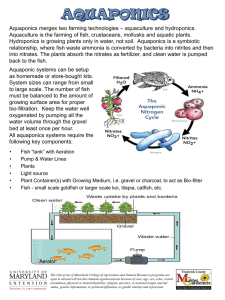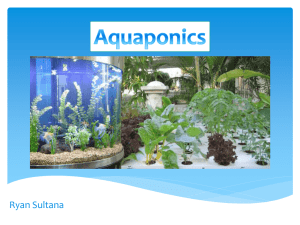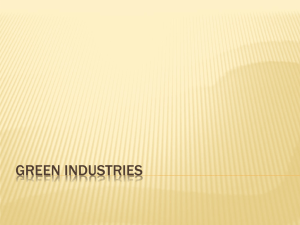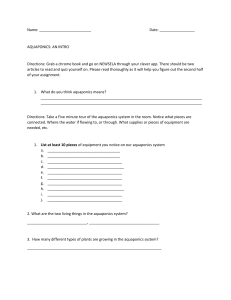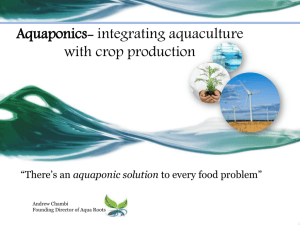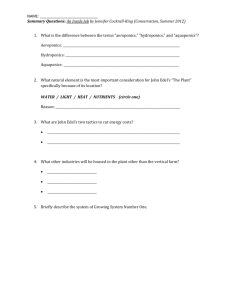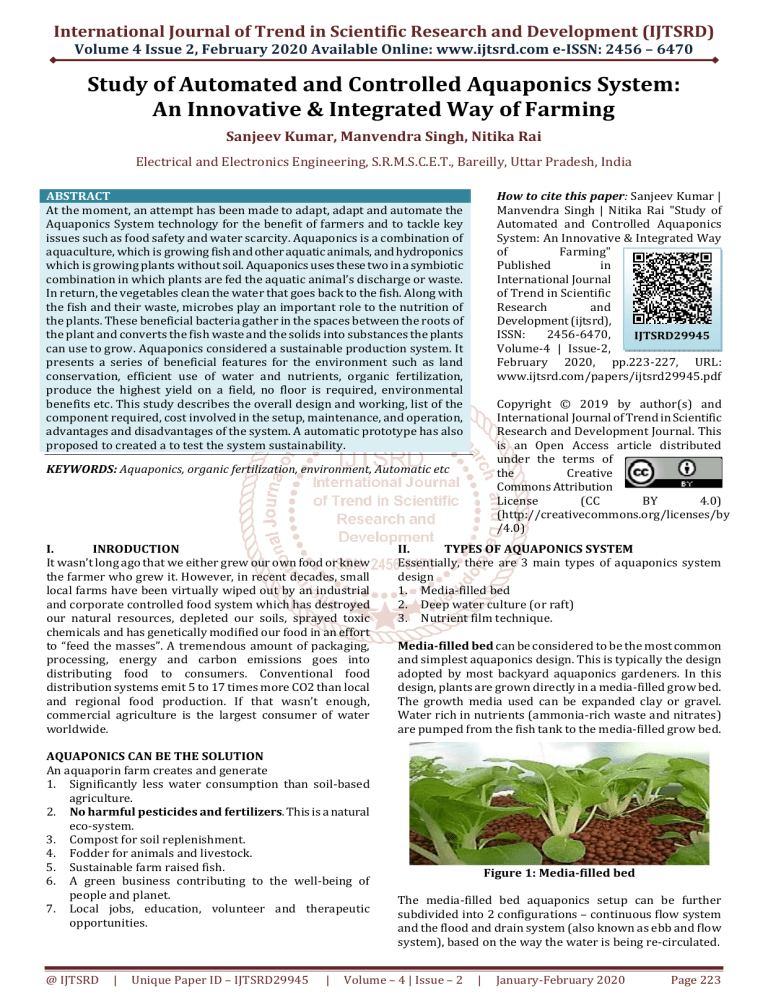
International Journal of Trend in Scientific Research and Development (IJTSRD)
Volume 4 Issue 2, February 2020 Available Online: www.ijtsrd.com e-ISSN: 2456 – 6470
Study of Automated and Controlled Aquaponics System:
An Innovative & Integrated Way of Farming
Sanjeev Kumar, Manvendra Singh, Nitika Rai
Electrical and Electronics Engineering, S.R.M.S.C.E.T., Bareilly, Uttar Pradesh, India
How to cite this paper: Sanjeev Kumar |
Manvendra Singh | Nitika Rai "Study of
Automated and Controlled Aquaponics
System: An Innovative & Integrated Way
of
Farming"
Published
in
International Journal
of Trend in Scientific
Research
and
Development (ijtsrd),
ISSN:
2456-6470,
IJTSRD29945
Volume-4 | Issue-2,
February 2020, pp.223-227, URL:
www.ijtsrd.com/papers/ijtsrd29945.pdf
ABSTRACT
At the moment, an attempt has been made to adapt, adapt and automate the
Aquaponics System technology for the benefit of farmers and to tackle key
issues such as food safety and water scarcity. Aquaponics is a combination of
aquaculture, which is growing fish and other aquatic animals, and hydroponics
which is growing plants without soil. Aquaponics uses these two in a symbiotic
combination in which plants are fed the aquatic animal’s discharge or waste.
In return, the vegetables clean the water that goes back to the fish. Along with
the fish and their waste, microbes play an important role to the nutrition of
the plants. These beneficial bacteria gather in the spaces between the roots of
the plant and converts the fish waste and the solids into substances the plants
can use to grow. Aquaponics considered a sustainable production system. It
presents a series of beneficial features for the environment such as land
conservation, efficient use of water and nutrients, organic fertilization,
produce the highest yield on a field, no floor is required, environmental
benefits etc. This study describes the overall design and working, list of the
component required, cost involved in the setup, maintenance, and operation,
advantages and disadvantages of the system. A automatic prototype has also
proposed to created a to test the system sustainability.
Copyright © 2019 by author(s) and
International Journal of Trend in Scientific
Research and Development Journal. This
is an Open Access article distributed
under the terms of
the
Creative
Commons Attribution
License
(CC
BY
4.0)
(http://creativecommons.org/licenses/by
/4.0)
KEYWORDS: Aquaponics, organic fertilization, environment, Automatic etc
I.
INRODUCTION
It wasn’t long ago that we either grew our own food or knew
the farmer who grew it. However, in recent decades, small
local farms have been virtually wiped out by an industrial
and corporate controlled food system which has destroyed
our natural resources, depleted our soils, sprayed toxic
chemicals and has genetically modified our food in an effort
to “feed the masses”. A tremendous amount of packaging,
processing, energy and carbon emissions goes into
distributing food to consumers. Conventional food
distribution systems emit 5 to 17 times more CO2 than local
and regional food production. If that wasn’t enough,
commercial agriculture is the largest consumer of water
worldwide.
AQUAPONICS CAN BE THE SOLUTION
An aquaporin farm creates and generate
1. Significantly less water consumption than soil-based
agriculture.
2. No harmful pesticides and fertilizers. This is a natural
eco-system.
3. Compost for soil replenishment.
4. Fodder for animals and livestock.
5. Sustainable farm raised fish.
6. A green business contributing to the well-being of
people and planet.
7. Local jobs, education, volunteer and therapeutic
opportunities.
@ IJTSRD
|
Unique Paper ID – IJTSRD29945
|
II.
TYPES OF AQUAPONICS SYSTEM
Essentially, there are 3 main types of aquaponics system
design
1. Media-filled bed
2. Deep water culture (or raft)
3. Nutrient film technique.
Media-filled bed can be considered to be the most common
and simplest aquaponics design. This is typically the design
adopted by most backyard aquaponics gardeners. In this
design, plants are grown directly in a media-filled grow bed.
The growth media used can be expanded clay or gravel.
Water rich in nutrients (ammonia-rich waste and nitrates)
are pumped from the fish tank to the media-filled grow bed.
Figure 1: Media-filled bed
The media-filled bed aquaponics setup can be further
subdivided into 2 configurations – continuous flow system
and the flood and drain system (also known as ebb and flow
system), based on the way the water is being re-circulated.
Volume – 4 | Issue – 2
|
January-February 2020
Page 223
International Journal of Trend in Scientific Research and Development (IJTSRD) @ www.ijtsrd.com eISSN: 2456-6470
Deep water culture or raft is predominately used for
commercial system as it is relatively inexpensive to set up
and a wide variety of leafy vegetables and herbs can be
grown. Holes are drilled on floating boards or foam rafts for
the pots. The plants are then grown in these pots with their
roots immersed in the water.
Figure 2: Deep water culture
The raft can be simply floated directly on top of the fish tank.
The more common approach, however, is to rear the fish in a
separate tank, pump the nutrient-rich water through a filter
and into long channels where rafts filled with plants are
floated on the water surface to absorb the nutrients.
Unfiltered water contains fish solids that may adhere to the
plants roots, hence affecting their ability to absorb water and
oxygen.
Nutrient film technique (also known as NFT aquaponics)
is the least commonly practiced aquaponics system design.
However, it is widely practiced for hydroponics.
Nutrient-rich water from the fish tank is pumped down small
enclosed channels.
DISADVANTAGES
High initial cost
To fill up water tanks
To build the system (Greenhouse, pumps)
Difficult to grow root crops
Requires skill and experience
Constant monitoring of water parameters
Pests and diseases can be devastating
Limitations concerned with fish species reared
III.
DESCRIPTION OF HARDWARE
Aquaponics uses the best of all the growing techniques,
namely Hydroponics, Aquaculture, and traditional
agriculture; utilizing the waste of one element to benefit
another mimicking a natural ecosystem. In Aquaponics, the
fish waste along with a significant volume of water it resides
in, does not need to be removed daily as it does in an
Aquaculture system. Costly plant food does not need to be
added as it would with a hydroponic system. Also, there is no
need to flush out the grow beds periodically to replace it
with water that is fresh and clean. Aquaponics thus becomes
a system of growing fish, produce, and other plants types in a
sustainable closed-loop system.
The Aquaponics System Cycle:
1. First the fish in the aquaponics tank are fed with fish
food supplied by the grower.
2. Fish secrete waste and ammonia that can be detrimental
to the fish in sufficient quantities.
3. The fish breathe in oxygen but exhale carbon. The water
is contaminated with fish waste and carbon. The fish
tank water is cycled into the plant grow bed media.
4. The grow bed media is a perfect environment to billions
of bacterial microbes that convert the ammonia initially
to Nitrite, and then to Nitrate.
5. The plant roots absorb the nutrient-rich Nitrate and the
carbon helping to clean the water while elevating the
health of the plant.
6. The purified water is poured back into the fish tank
while oxygenating it at the same time.
Figure 3: Nutrient film technique
In most NFT aquaponics setup, holes are being drilled along
the length of medium-sized PVC pipes. Alternatively, secondhand gutters can be used. The amount of water trickling
through the base of the channels is so small that it only
forms a very thin film.
ADVANTAGES
Reduced labour
Aquaponics uses 90% less water than traditional
farming
DO NOT require farm land and soil
Fish feed is the only nutrient inputs
Aquaculture waste products are used
Aquaponics protects our rivers & lakes
Health & Nutrition value high
Higher production rate
Provides income from two separate products
@ IJTSRD
|
Unique Paper ID – IJTSRD29945
|
Figure 4: Cycle of Aquaponics System
Volume – 4 | Issue – 2
|
January-February 2020
Page 224
International Journal of Trend in Scientific Research and Development (IJTSRD) @ www.ijtsrd.com eISSN: 2456-6470
IV.
LAYOUTS OF PROPOSED MODEL
Figure 6: Hard ware circuit connection diagram of the
proposed System
Figure 5: Design & Construction layouts of the
proposed System.
Figure 7: Hardware implementations of the proposed System.
Cost of operation and maintenance:
Subject
Remarks
Estimated costs
Fish fingerlings
Once every new batch of fish is to be reared.5 to 8 months.
500/-
Plant seeds
Fish feed
Once for every new harvest for 2 to 4 months for leafy
vegetables.
As per the daily requirement. 10 kg will last for a batch of
ten fish over the full growing period.
300/500/- for 10 kgs
Water quality check
Once every week such as pH and turbidity.
Negligible
Electricity
According to the amount of time grow light is used and
wattage of water pump
1000/- per month
Miscellaneous maintenances
and depreciation.
Unforeseen repair and aging of components
5% per annum
V.
COMPONENT REQUREMENT FOR AUTOMATIC AND CONTROLLED SYSTEM
The components of the aquaporin system may vary in size or style but each system requires a fish tank, a grow bed or beds,
plumbing, plants, and fish. To illustrate this, a prototype model prepared that is controlled and automated by a Bluetooth
controlled switch.
@ IJTSRD
|
Unique Paper ID – IJTSRD29945
|
Volume – 4 | Issue – 2
|
January-February 2020
Page 225
International Journal of Trend in Scientific Research and Development (IJTSRD) @ www.ijtsrd.com eISSN: 2456-6470
Component
Grow beds
Fish tanks
Quantity
3
2
Sump tank
P.V.C pipes (different diameter)
Elbows, tees, & valves
Aerator pump
Water pump
Grow lights
1
10 meters
10,10,&3
1
1
9
Bio filter media
Mechanical filter
Arduino Uno board
HC-06 bluetooth module
Wires
8 port relay switch
3 kgs
1
1
1
10 meters
1
Miscellaneous (nails, bolts, etc)
As per req.
SPECIFICATIONS OF COMPONENTS OF PROPOSED
MODEL:
Foot space acquired by the System: 48 sq. feet (8”x6”)
Height of the system: 10 feet
Number of grow beds: 3
Number of fish tanks: 2
Amount of grow space: 144 sq. feet (triple the foot space
acquired)
Grow bed: 60x40x32.5cms
Fish tank: 60x40x32.5cms
P.V.C. PIPES & FITTINGS diameter/s: 1’’ and 1.5’’
Stand: 8x6x10 feet (5 racks)
Water Pump: .5 HP
Grow lights: 4.9 watts (x9)
Control Switches: Arduino based Bluetooth switch
VI.
CONCLUSION
By combining aquaculture and hydroponic systems
aquaponics built whereby nutrient rich waste water from
the aquaculture system is utilized into the hydroponic
system.
Aquaponics system has many untapped potentials, this way
of farming can really help the community in a big way. It can
be the solution for the serious problems like water scarcity,
food security, and its purity. It uses minimal resources and
gives a better yield, both in terms of quality and quantity. It
has no ill effects on environments and if used on a larger
scale could help in tackling the problems of water pollution
and soil degradation due to the conventional use of chemical
fertilizers and pesticides. In this era in which land is a rare
commodity it could be a valuable step towards getting higher
yields from land in terms of nutrition.
In aquaponics, wastewater from aquaculture is filtered and
is recirculated into the system. An aquaponics shows an
opportunity to rethink the conventional fish farming, to
bring in more money farm
@ IJTSRD
|
Unique Paper ID – IJTSRD29945
|
VII.
FUTURE SCOPE
Simplicity in design and management with essentially no ene
rgy and low cost of equipment makes these systems an inter
esting solution wherever land availability, flooding, producti
vity but also ecological footprint are a major issue. In
addition the employ of water weeds as a resource can
certainly increase livelihoods opportunities in all those areas
affected worldwide. Further research needs to address the
nutrient dynamics of different growing media and to
optimize system design and nutritional requirement of
vegetables in those water bodies with limited dissolved
nutrients. The possibilities of this integrated system are
quite strong and can give both smallholders and big
aquaculture companies’ responsive benefits. Moreover, the
potential of these frameworks is not fully understood and
interdisciplinary interconnections and study will definitely
resolve many of the still unidentified issues.
REFERENCES
[1] Diver S, 2006. Aquaponics—Integration of Hydroponics
with Aquaculture (Internet). ATTRA- National
Sustainable Agriculture Information Service. Available
from:
<http://attra.ncat.org/attrapub/PDF/aquaponic.pdf> (2006). Print.
[2] Duong Tan Nhut , Nguyen Hoang Nguyen, Dang Thi Thu
Thuy, ″A novel in vitro hydroponic culture system for
potato (Solanum tuberosum L.) microtuber
production″, Science Direct (2006). Print.
[3] Gordon A Chalmers, ″Aquaponics and Food Safety″,
Lethbridge, Alberta (2004). Print.
[4] Hutchinson, W, Jeffrey, M, O’Sullivan, D., Casement, D.,
Clarke, S., ″ Recirculating Aquaculture Systems:
Minimum Standards for Design, Construction and
Management. ″, Inland Aquaculture Association of
South Australia Inc. (2004). Print.
[5] Jensen, M. H., "Hydroponics.", Hort Science, 32.6
(1997): 1018–1021. Print. Malcolm, J., ″What is
aquaponics?″, Backyard Aquaponics, Issue 1, Summer
(2007). Print.
[6] Nichols M, ″Aquaponics: Where One Plus One Equals
Three″, Massey University, Palmerston North, New
Volume – 4 | Issue – 2
|
January-February 2020
Page 226
International Journal of Trend in Scientific Research and Development (IJTSRD) @ www.ijtsrd.com eISSN: 2456-6470
zealand, Maximum Yeld- Indoor gardening, UK
January-February (2008). Print.
York, NY, United States: New Society Publishers
(2011).
[7] Pantanella, E., ″Pond aquaponics: new pathways to
sustainable integrated aquaculture and agriculture″,
Aquaculture News, May (2008). Print.
[10] Long, B. The EZ guide to aeroponics, hydroponics and
aquaponics: [how to create a sustainable food supply].
Texas: Bonjour Limited Holding s (2012)
[8] Rakocy, James E.; Masser, Michael P.; Losordo, Thomas
M. Recirculating aquaculture tank production systems:
Aquaponics — integrating fish and plant culture (454).
Southern Regional Aquaculture Center. (November
2006). Print.
[11] Somerville, C. Small-scale Aquaponic food production:
Integrated fish and plant farming. Rome, Italy, Italy:
Food & Agriculture Organization of the United Nations
(FAO) (2014).
[9] Bernstein, S. Aquaponic gardening: A step-by-step
guide to raising vegetables and fish together. New
@ IJTSRD
|
Unique Paper ID – IJTSRD29945
|
[12] Panigrahi G. K., Sasmita Panda and Surendra Nath
Padhi; ”Aquaponics: An innovative approach of
symbiotic farming” International Journal of Bioassays
5.9 (2016): 4808-4814
Volume – 4 | Issue – 2
|
January-February 2020
Page 227

